
We place and restore a lot of dental implants. We work hard to incorporate the best modern technology that makes implantology more predictable and flow more smoothly. We are one of very few dental facilities with an in-house Dental Laboratory and a full time Dental Technician. I think that it is most often an advantage for the dentist who is placing implants to be the dentist who does the extractions.
He'll have a better sense of what the tissue looked like and, if grafting is involved for socket preservation, he uses the grafting material and approach that he prefers. I couldn't recommend anyone more highly. Dr. Hunt lectures internationally, and he has been involved in teaching, writing, research and product development.
He'll have a better sense of what the tissue looked like and, if grafting is involved for socket preservation, he uses the grafting material and approach that he prefers. I couldn't recommend anyone more highly. Dr. Hunt lectures internationally, and he has been involved in teaching, writing, research and product development.
Services
Let's start with the person that you are most likely to meet when you first come into the office, Ella, our Office Manager, has worked with us for many years. She came here as a refugee from Estonia, where she had been a Civil Engineer. Her english was limited at first, so she started helping with instruments and room preparation.
The simple answer is that it best starts when the tooth is removed. If an extraction socket is allowed to heal naturally, then the bone and soft tissues of the region that supported the tooth tend to fade away very quickly, even to the point where it can be impossible to place implants. This is where a graft material of one form or another is placed into the socket.
Every case starts with assessing the individual situation for each patient and preparing a Treatment Plan and providing a cost estimate. It involves taking various forms of radiographs, often some photographs and digital scans to generate models of your dentition. In most cases, some time is needed for merging radiographs with intra-oral scans, 3D printing of models, development of Surgical Guides and preparing Provisional restorations.
1. Intra Oral Radiography is a regular image that allows us to examine an individual tooth or area. 3. Cone Beam Computed Tomography Scan gives us a 3D view of the jaws to get a true representation of the bone and soft tissue volumes available for implant placement. Instead of using traditional impressions, we now use Digital Intra-Oral Scanning.
Guided surgery is where the implant is placed to a particular place in the jaws using Robotic Surgery or a Surgical Guide. We use Surgical Guide Protocols. This allows us to "Pre-Position" implants precisely using digital software on a planning computer. This in turn allows us to 3-D print models of your mouth with a replica of the implant placed in the desired position.
Reviews (1)
Casey Fahey
May 28, 2021
Report
An amazing experience. I accompanied my SO to get an implant. The procedure and recovery were virtually painless, and the Doctor was personable and engaging with all present. A procedure new to the US was proposed to address a specific bone loss condition.
It is important to understand that this office is not really your standard dentist's office -- they are engineers specializing in complex procedures like implants and bone grafts. The entire office is the best-of-the-best and on the proverbial bleeding edge.
It is important to understand that this office is not really your standard dentist's office -- they are engineers specializing in complex procedures like implants and bone grafts. The entire office is the best-of-the-best and on the proverbial bleeding edge.



